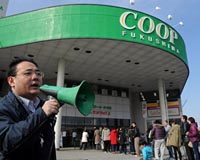| . |  |
. |
Osaka (AFP) March 23, 2011 Japan on Wednesday said the cost of rebuilding the country after its biggest recorded earthquake could be as much as 25 trillion yen ($309 billion) as a deepening radiation scare hit shares. In the biggest estimate so far, Japan put the cost of the earthquake-tsunami disaster at more than twice that inflicted by the 1995 Kobe quake. The World Bank has said Japan needs up to five years to rebuild. Analysts warn however that the figure may rise the longer an atomic crisis at the stricken Fukushima nuclear plant remains unresolved, with an ongoing radiation scare threatening the capital Tokyo, 250 kilometres (155 miles) away. "The damage is far bigger than the Kobe quake," Japan's economy minister Kaoru Yosano told a press conference, adding "it will take a long time to complete reconstruction." Japanese shares, which had been slightly lower on profit-taking after two days of strong gains, fell sharply in late trade after the Tokyo Metropolitan government said levels of radioactive iodine exceeded safe limits for infants for two consecutive days. "This is a huge setback, as we expected the impact from the nuclear radiation to be limited up to this point," said Yumi Nishimura, deputy general manager at Daiwa Securities. The Nikkei 225 index ended down 1.65 percent, or 158.85 points to 9,449.47. The Topix index slipped 7.03 points, or 0.81 percent, to 861.10. Markets are vulnerable to signs of setback in delicate operations to restore power to overheating reactors at the leaking Fukushima atomic plant crippled by the March 11 disaster. Japan's food contamination scare has rippled across the world. The United States blocked imports of dairy and other produce from regions around the disaster-struck power plant. Japan ordered the halt of shipments of a range of farm products grown near the Fukushima facility after health ministry tests found vastly elevated levels of iodine and caesium. The twin disasters have plunged Japan into what Prime Minister Naoto Kan has called its worst crisis since World War II. The top end of the government's estimate puts its cost at more than double that of the 9.6 trillion yen impact of the Kobe earthquake, and four times that of Hurricane Katrina's $81 billion cost in the United States. The total cost from collapse or damage to houses, factories and infrastructure such as roads and bridges was estimated at 16 trillion-25 trillion yen over the next three fiscal years, the Cabinet Office said. "The scale of the loss due to the earthquake and tsunami will be unprecedented," noted Susumu Kato of Credit Agricole. Hundreds of thousands have been made homeless by the 9.0-magnitude quake and the devastating tsunami it unleashed, which erased entire towns. The confirmed death toll from the disaster rose Wednesday to 9,408, and Japan holds little hope for 14,716 officially listed as missing. A mammoth rebuilding task will be required in its aftermath but Japan faces a huge challenge in financing it without expanding a public debt that is already the industrialised world's biggest at around 200 percent of GDP. The nation's credit rating was recently downgraded on concerns that not enough is being done to address it. Production halts at some of Japan's top companies due to damaged facilities, rolling power outages and broken supply chains crucial to making cars, electronic gadgets and machinery have hammered output. Transport networks along the northeast have been shattered. In a bid to soothe financial markets and ensure institutions have enough funds in the face of spiking demand, the Bank of Japan has pumped a record 40 trillion yen into the financial system to boost confidence since the disaster. It did not inject funds Wednesday. Dealers said the BoJ was also playing its part to increase the effectiveness of a concerted intervention by Japan and its Group of Seven partners aimed at weakening the yen by leaving the money in the system, boosting supply. The Japanese unit was flat against the dollar from 80.92 late Tuesday in New York after surging to a post World War II high last week under 77 yen to the dollar. The yen was also up at 114.49 to the euro from 115.11. -- Dow Jones Newswires contributed to this story --
Share This Article With Planet Earth
Related Links Bringing Order To A World Of Disasters A world of storm and tempest When the Earth Quakes
 Baby steps for small business after Japan tsunami
Baby steps for small business after Japan tsunamiKesennuma, Japan (AFP) March 22, 2011 It's hard to see how business can thrive in the post-tsunami devastation in Japan, but consumer demand is running high - and Sayuri Miyakawa is determined to supply it. Days after a tsunami reduced her seaside grocery store in Kesennuma to driftwood, Miyakawa was back in business, albeit with no shop, no cash and virtually no produce. With something like half a million people living in ... read more |
|
| The content herein, unless otherwise known to be public domain, are Copyright 1995-2010 - SpaceDaily. AFP and UPI Wire Stories are copyright Agence France-Presse and United Press International. ESA Portal Reports are copyright European Space Agency. All NASA sourced material is public domain. Additional copyrights may apply in whole or part to other bona fide parties. Advertising does not imply endorsement,agreement or approval of any opinions, statements or information provided by SpaceDaily on any Web page published or hosted by SpaceDaily. Privacy Statement |